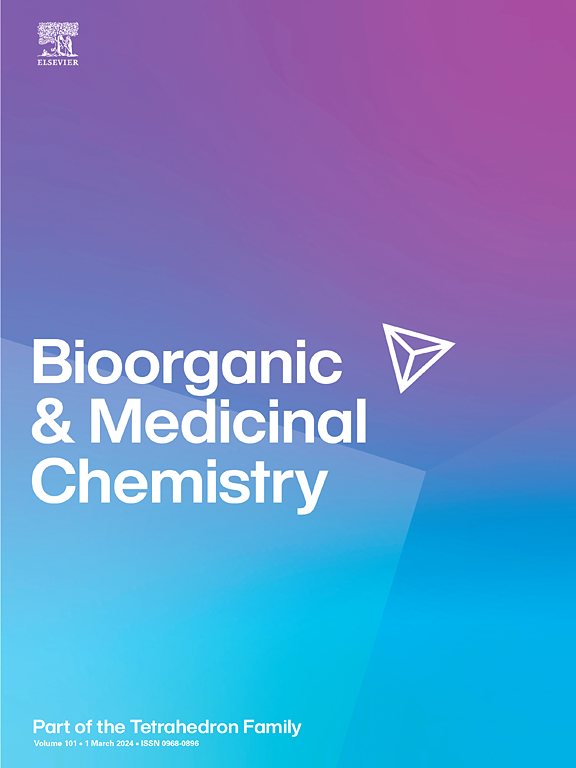De novo discovery of cyclic peptide inhibitors of IL-11 signaling
IF 3.3
3区 医学
Q2 BIOCHEMISTRY & MOLECULAR BIOLOGY
引用次数: 0
Abstract
Interleukin-11 (IL-11), a member of the IL-6 cytokine family, has potential pro-inflammatory and pro-fibrotic roles in pulmonary, hepatic, cardiovascular, renal and intestinal disease pathogenesis, including oncogenesis. The potential for therapeutic intervention in these disease spaces has therefore made the IL-11 signaling axis an attractive target in drug discovery, and antibody inhibitors of IL-11 signaling are currently under evaluation in Phase I/II clinical trials. While lower molecular weight small molecule and peptide inhibitors may offer the potential for improved tissue penetration, developability and manufacturing cost compared with a protein therapeutic, reports of such chemical matter in the literature are limited. In this work, a series of cyclic peptides derived from phage display biopanning campaigns against both IL-11 and its cognate receptor IL-11Rα are presented. The most active IL-11 binder (peptide 4, KD 140 nM) exhibited inhibition of IL-11/IL-11Rα dimerization in a biochemical AlphaLISA assay (Ki 300 nM), and alanine scanning was carried out on this sequence to identify residues important for target binding and inhibitory activity. Further structural optimization yielded lead peptide 15 (Ki 180 nM), which exhibited at least 70-fold greater activity than IL-11 inhibitors previously reported in the literature. The de novo peptide macrocycles presented serve as a robust starting point for development of therapeutic inhibitors of the IL-11/IL-11Rα interaction.

IL-11信号通路环肽抑制剂的新发现。
白细胞介素-11 (IL-11)是IL-6细胞因子家族的一员,在肺、肝、心血管、肾和肠道疾病的发病包括肿瘤发生中具有潜在的促炎和促纤维化作用。因此,对这些疾病空间进行治疗干预的潜力使IL-11信号轴成为药物发现的一个有吸引力的靶点,IL-11信号的抗体抑制剂目前正在I/II期临床试验中进行评估。虽然与蛋白质治疗药物相比,低分子量小分子和肽抑制剂可能提供改善组织渗透、可开发性和制造成本的潜力,但文献中关于此类化学物质的报道有限。在这项工作中,提出了一系列从噬菌体展示生物筛选运动中获得的环肽,这些运动可以对抗IL-11及其同源受体IL-11Rα。在生化AlphaLISA实验(Ki 300 nM)中,最活跃的IL-11结合物(肽4,KD 140 nM)显示出对IL-11/IL-11Rα二聚化的抑制作用,并对该序列进行丙氨酸扫描,以确定对目标结合和抑制活性重要的残基。进一步的结构优化得到导联肽15 (Ki 180 nM),其活性比先前文献报道的IL-11抑制剂至少高70倍。新发现的肽大环为开发IL-11/IL-11Rα相互作用的治疗性抑制剂提供了强有力的起点。
本文章由计算机程序翻译,如有差异,请以英文原文为准。
求助全文
约1分钟内获得全文
求助全文
来源期刊

Bioorganic & Medicinal Chemistry
医学-生化与分子生物学
CiteScore
6.80
自引率
2.90%
发文量
413
审稿时长
17 days
期刊介绍:
Bioorganic & Medicinal Chemistry provides an international forum for the publication of full original research papers and critical reviews on molecular interactions in key biological targets such as receptors, channels, enzymes, nucleotides, lipids and saccharides.
The aim of the journal is to promote a better understanding at the molecular level of life processes, and living organisms, as well as the interaction of these with chemical agents. A special feature will be that colour illustrations will be reproduced at no charge to the author, provided that the Editor agrees that colour is essential to the information content of the illustration in question.
 求助内容:
求助内容: 应助结果提醒方式:
应助结果提醒方式:


